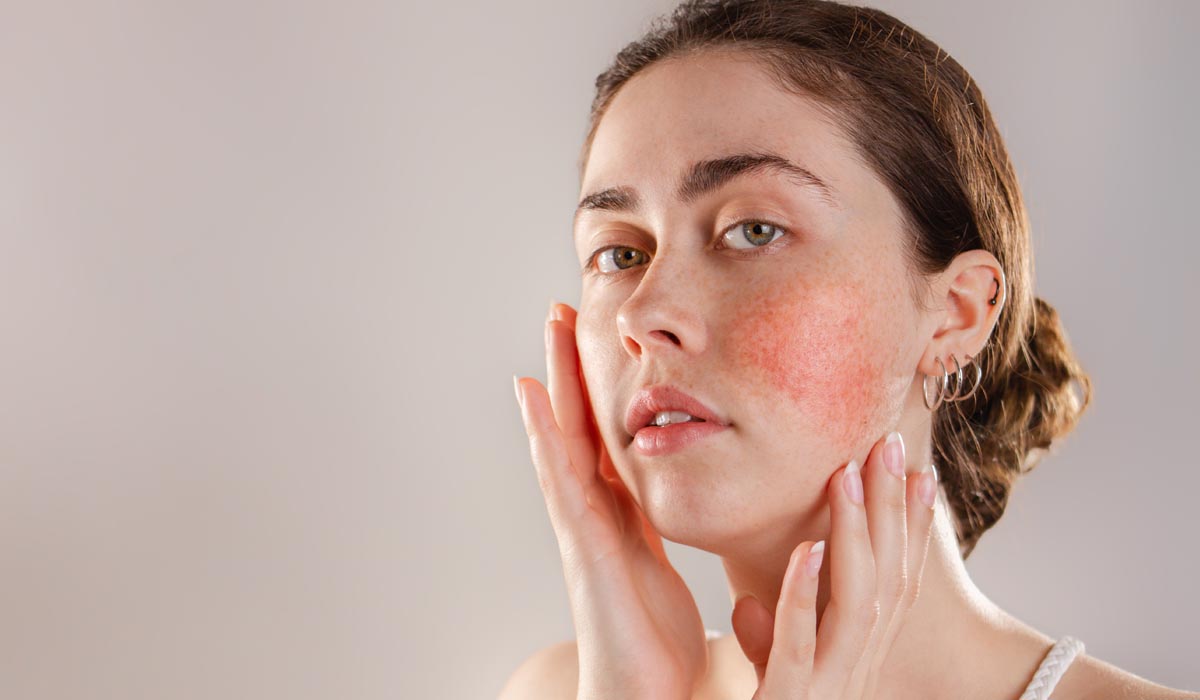✨Book online and enjoy a 5% discount on your first consultation
Home » Dermatology Services » Rosacea

Medical Service Name – Rosacea
Rosacea is a skin disorder that causes the blushing of small blood vessels in your face. It mainly happens near the nose, cheeks, chin, and forehead. If you overlook the symptoms, the red patches may become more intense and flare up within weeks. Sometimes, people may mistakenly consider rosacea for acne, natural patches, and other skin issues. It is a common skin disease that can affect anyone at any age. Rosacea tends to be more noticeable in persons with fair complexion. Generally, this skin issue occurs in adolescence and adults over the age of 30. Women, in particular, are more likely than males to have this disease.
People may develop this skin disease on the chest, scalp, or neck area. This disorder can lead to severe problems, including pus-filled pimples, red bumps, and swollen nose. For many people, it can spread to the eyes. You might have dry and swollen eyelids that are known as ocular rosacea. With proper medication, you can heal this skin disorder before it gets too late.
Possible Causes
Specifically, the reason for rosacea is still unknown. As per the medical theories, the causes of this skin issue occur due to an overactive immune system, blood vessels disorder, heredity, or environmental factors. Some research shows fungus, microscopic skin mites, and connective tissue malfunctions may result in rosacea. A few situations might trigger the intensity of this skin issue.
Risk Factor
Rosacea may affect everyone. However, you’re more likely to get it if you:
Sign & Symptoms
The symptoms of this skin disease may vary from one individual to another. Many times, you may not understand the signs of the disorder.
Facial flushing or blushing can be experienced by many individuals who have this disorder in the focus point of the face. If the facial redness comes and disappears, consider it as an early sign of rosacea. Pus-filled pimples and small red bumps often develop if you are suffering from it. To some extent, it looks like acne without blackheads. But there will be a burning sensation.
Furthermore, small blood vessels become visible on your nose, cheeks, and facial area. The redness of the facial skin might resemble blush or sunburn. Your affected area might feel tender & hot.
Some people might experience dry, itchy, and swollen eyelids. From ocular rosacea, you may develop further skin issues.
Diagnosis
To diagnose rosacea, no particular test is performed. Instead, the doctor will examine your skin and take a history of your symptoms. Other illnesses, such as psoriasis or lupus, may be ruled out using testing. According to studies, rosacea can be ignored or misinterpreted in individuals of colour as an allergic response or seborrheic dermatitis.
Our doctor may send you to an eye specialist (ophthalmologist) for assessment if your symptoms concern your eyes.
Treatment Options at 7DMC
There is no such definite test for identifying this respective skin disease. Our specialists at 7DMC may conduct a few examinations to understand the source of this problem. If you have encountered any of these signs like redness, burning skin, and bumps on the skin, you must consult our dermatologist.
7DMC offers extensive treatment plans that might help you cure rosacea. Depending on the condition of the disease, our aesthetic dermatologists may prescribe medicines that can control your pimples, red bumps, and itchiness.
We also provide laser therapy and surgical treatment to remove blood vessels visible on the facial skin by following proper procedures. Enlarged blood vessels can be made less apparent by laser treatment. Since the laser treats visible veins, it works best on skin that isn’t tanned, dark, or black.
Although many people have symptoms from more than one form of rosacea, there are four varieties:
Rosacea is a chronic skin condition that does not go away. It can go into remission, and flare-ups can occur at any time. If not addressed, irreparable harm might occur. This damage is crucial since it might harm a patient’s eyes and produce lifelong skin redness.
Yes. Although rosacea has a diverse course and is not predicted in everyone, it worsens with age, mainly if left untreated. According to modest studies, many rosacea patients have claimed that without therapy, their illness has progressed from early to mid stage within a year.
Near Dubai Miracle Garden,
Diamond Business centre A,
1st Floor,
Arjan, AI Barsha,
Dubai.
WhatsApp us